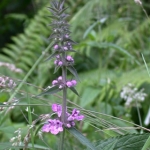| Common Name: |
Marsh Woundwort |
| Botanical Name: |
Stachys palustris |
| Genus: |
Stachys |
| Family: |
Lamiaceae |
| Native Location: |
Europe |
| Cultivation: |
Well-drained soil in sun or partial shade. Stachys palustris needs damp to wet soil, or water to 8cm (3in) deep. |
| Propagation: |
By seed sown in autumn or spring; by division in spring. |
| Harvest: |
Flowering plants are cut in summer and dried for infusions, liquid extracts, and tinctures. |
| Height: |
1m (3ft) |
| Width: |
30-45cm (12-18in) |
| Hardiness: |
Z4-8 |
| Parts Used: |
Whole plant |
| Properties: |
An astringent, antiseptic herb with an unpleasant smell. It relaxes spasms, controls bleeding, and promotes healing. |
| Medicinal Uses: |
Internally for gout, cramp, vertigo, and hemorrhage. Externally for minor injuries. |
| Bibliography: |
Encyclopedia of Herbs by Deni Brown Copyright © 1995, 2001 Dorling Kindersley Limited Pg 374 |

